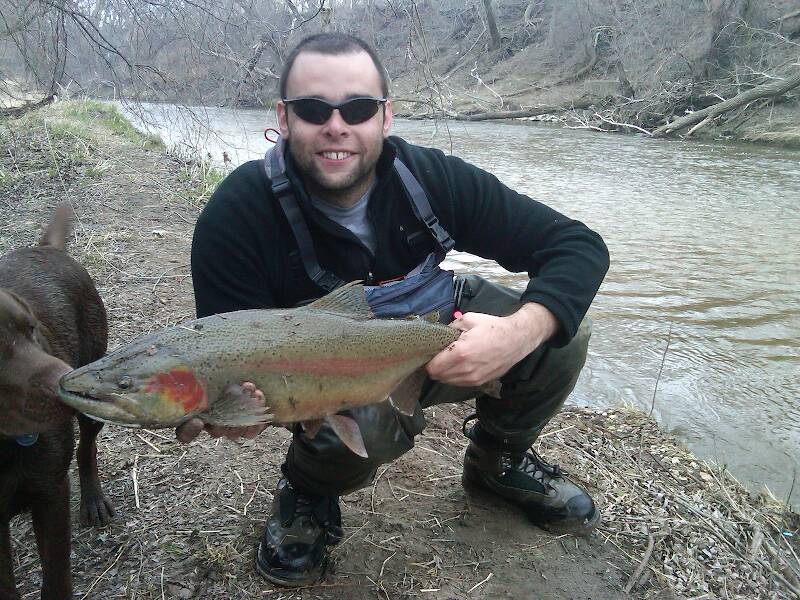
Blue-winged Olives
Baetis
Tiny Baetis mayflies are perhaps the most commonly encountered and imitated by anglers on all American trout streams due to their great abundance, widespread distribution, and trout-friendly emergence habits.
Featured on the forum

This wild-looking little thing completely puzzled me. At first I was thinking beetle or month larva, until I got a look at the pictures on the computer screen. I made a couple of incorrect guesses before entomologist Greg Courtney pointed me in the right direction with Psychodidae. He suggested a possible genus of Thornburghiella, but could not rule out some other members of the tribe Pericomini.

Troutnut is a project started in 2003 by salmonid ecologist Jason "Troutnut" Neuswanger to help anglers and
fly tyers unabashedly embrace the entomological side of the sport. Learn more about Troutnut or
support the project for an enhanced experience here.
Lastchance on Sep 21, 2012September 21st, 2012, 4:42 am EDT
Just wondering! Is it me or do I find most rods rated heavier than advertised? Most 5 wts. seem to lean to 4s, and 4s to 3s, etc. I only have experience with 3, 4, 5, and 6 wt. rods. Maybe it's just the lower priced rods, which I buy.
Bruce
Bruce
Taxon on Sep 21, 2012September 21st, 2012, 6:26 am EDT
Hi Bruce,
Although I certainly don't know the answer to the question you pose, I can't help but be curious concerning the specifics of what you have been experiencing, which may have led you to conclude that rods you use tend to be rated heavier than they actually are. I guess the reason this surprises to me is that I seem to recall seeing more questions about over-lining rods, than I have seen about under-lining them. Please elaborate.
Although I certainly don't know the answer to the question you pose, I can't help but be curious concerning the specifics of what you have been experiencing, which may have led you to conclude that rods you use tend to be rated heavier than they actually are. I guess the reason this surprises to me is that I seem to recall seeing more questions about over-lining rods, than I have seen about under-lining them. Please elaborate.
PaulRoberts on Sep 21, 2012September 21st, 2012, 7:10 am EDT
That may be. I was recently wondering that too, since breaking out some older rods lately. Although of high quality (Loomis) they are very soft. I've since replaced them, going up in power. Again, the standard formula, if I remember correctly, is a certain mass (line weight) at 30feet. My older rods likely fit that formula although I don't know how to test that.
From there though it appears that liberties are taken to achieve marketing objectives. Price does not seem to be the that much of a factor. For instance I've noticed that the lower Redington lines sport a lot of power and I'd say are under-rated in power. I noticed bc I like them that way.
Another factor, where price does come into play, is with graphite quality (MOE/stiffness) and rod length. It takes higher MOE graphite to make a long rod crisp. Lower MOE (like cheaper, older) graphites require more material to build up power and it results in a heavier more sluggish stick. It's easier and cheaper to make a crisp fast rod in shorter lengths. The cutoff seems to be about 8ft. I generally expect to pay more for long rods.
Roger, I wonder if the interest in over-lining isn't a response to anglers trying to slow down more powerful or faster actions.
From there though it appears that liberties are taken to achieve marketing objectives. Price does not seem to be the that much of a factor. For instance I've noticed that the lower Redington lines sport a lot of power and I'd say are under-rated in power. I noticed bc I like them that way.
Another factor, where price does come into play, is with graphite quality (MOE/stiffness) and rod length. It takes higher MOE graphite to make a long rod crisp. Lower MOE (like cheaper, older) graphites require more material to build up power and it results in a heavier more sluggish stick. It's easier and cheaper to make a crisp fast rod in shorter lengths. The cutoff seems to be about 8ft. I generally expect to pay more for long rods.
Roger, I wonder if the interest in over-lining isn't a response to anglers trying to slow down more powerful or faster actions.
Kschaefer3 on Sep 21, 2012September 21st, 2012, 7:43 am EDT
I have started doing a bit more musky on the fly this year and over-lining seems to be used a lot for this. From my experience and conversations, it seems this is mostly to throw bigger/more wind resistant flies. If you throw small aerodynamic singles, you can throw just fine with your correct line weight. When you move into doubles, triples, and especially poppers it makes casting, with any distance, a much bigger challenge.
Paul, I think you make a very good point about slowing down your rod. With those bigger flies I find it easier to cast if you slow everything down. When I first started out it seemed to take a year before the loop would open and the rod load. If you try to cast too fast you will lose all momentum and end up with a mess at your feet. Over-lining helps keep that energy through the cast, and the cast tends not to collapse as much.
However, I do not over-line. I believe there are lines in each line class that will suit your specific rod and application. That is just in my limited experience.
My experience with over-lining is all for muskies with a 10 wt, I imagine the same holds true for 3, 4, 5, 6 wts though.
Paul, I think you make a very good point about slowing down your rod. With those bigger flies I find it easier to cast if you slow everything down. When I first started out it seemed to take a year before the loop would open and the rod load. If you try to cast too fast you will lose all momentum and end up with a mess at your feet. Over-lining helps keep that energy through the cast, and the cast tends not to collapse as much.
However, I do not over-line. I believe there are lines in each line class that will suit your specific rod and application. That is just in my limited experience.
My experience with over-lining is all for muskies with a 10 wt, I imagine the same holds true for 3, 4, 5, 6 wts though.
PaulRoberts on Sep 21, 2012September 21st, 2012, 8:08 am EDT
With those bigger flies I find it easier to cast if you slow everything down. When I first started out it seemed to take a year before the loop would open and the rod load. If you try to cast too fast you will lose all momentum and end up with a mess at your feet. Over-lining helps keep that energy through the cast, and the cast tends not to collapse as much.
Kschaefer3, Interesting you say that bc I believe you are right on with what's happening in the rod when you overline. Distance casting tournaments are won with slow action rods of great power. They store more energy and throw it more smoothly and efficiently.
People sometimes confuse power and action, evidenced by the seemingly contradictory idea that if you cut some of the tip off a rod it actually becomes slower in action, but feels so much stiffer. It has the same amount of power though. That tip is what's throwing the weight in faster rods, while a slower rod distributes the power over a longer length.
If you over-line (a properly rated rod) you have to reach deeper into the blank to support it, essentially slowing the action of the rod, and your casting stroke must slow down with it.
I agree with you that to throw a certain sized fly requires a certain amount of mass in the line to do it. One way is to overline (and adjust your stroke) or, go up in rod power -trade your 10 for an 11 or 12.
GONZO on Sep 21, 2012September 21st, 2012, 8:12 am EDT
Bruce,
Manufacturers' recommendations are just that, and they are only "correct" in the abstract. Even when a standardized method is used to determine line weight guidelines (for example, a specific weight producing a certain amount of deflection), personal casting style/preference will change the equation. Casting styles aside, a given rod might perform best with different line weights depending on the job at hand (fishing distance, added weight, fly size, wind, etc.). Even line "weight" is variable because it is usually based on a range of weights for a given number designation and is distributed differently over the same length in different lines.
Any rod can cast multiple line weights. Some casters will prefer a lower line weight (particularly with slower or softer rods), and some will prefer a higher line weight (particularly with faster or stiffer rods). Some will prefer a higher line weight for close-in work, and those who regularly aerialize a lot of line might prefer a lower line weight. For example, I have a slow, soft 6 1/2' small-stream rod that I built many moons ago on an old Fenwick HMG blank. The blank was originally rated for a #5, but I usually prefer to fish it with a #3 (or even a #2). Going beyond manufacturers' recommendations is simply a way to customize or personalize performance. Sometimes changing line weights can magically transform what seems to be a sluggish or insensitive stick into a more pleasing "wand."
Manufacturers' recommendations are just that, and they are only "correct" in the abstract. Even when a standardized method is used to determine line weight guidelines (for example, a specific weight producing a certain amount of deflection), personal casting style/preference will change the equation. Casting styles aside, a given rod might perform best with different line weights depending on the job at hand (fishing distance, added weight, fly size, wind, etc.). Even line "weight" is variable because it is usually based on a range of weights for a given number designation and is distributed differently over the same length in different lines.
Any rod can cast multiple line weights. Some casters will prefer a lower line weight (particularly with slower or softer rods), and some will prefer a higher line weight (particularly with faster or stiffer rods). Some will prefer a higher line weight for close-in work, and those who regularly aerialize a lot of line might prefer a lower line weight. For example, I have a slow, soft 6 1/2' small-stream rod that I built many moons ago on an old Fenwick HMG blank. The blank was originally rated for a #5, but I usually prefer to fish it with a #3 (or even a #2). Going beyond manufacturers' recommendations is simply a way to customize or personalize performance. Sometimes changing line weights can magically transform what seems to be a sluggish or insensitive stick into a more pleasing "wand."
Quick Reply
Related Discussions
Topic
Replies
Last Reply
14
Apr 18, 2011
by Troutnut
by Troutnut




